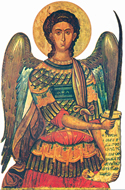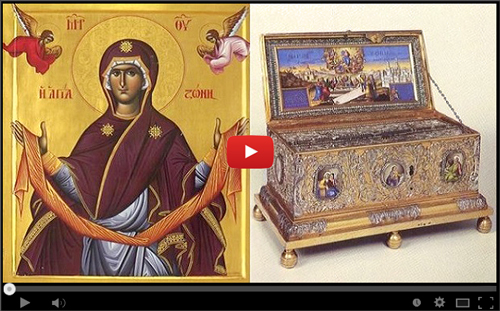 Loading... Please wait...
Loading... Please wait...Search our Talks
MP3 Downloads
Update on New Talks
The Belt of the Theotokos and the Pandemic of 1910
The Belt of the Theotokos and the Pandemic of 1910
To watch the video, click here.
Transcript:
During the year 1910 a terrible outbreak of Cholera was plaguing Constantinople and its suburbs. Hundreds of people died daily in this multicultural city, irrespective of their nationality or religious affiliation. Greek Orthodox, Armenians, Moslems and Jews could not be buried fast enough. The terrified multitudes of the city of Constantinople were desperately seeking for some miraculous salvation.
The Churches of the Orthodox and of the Armenians, the Mosques and the Synagogues were full of desperate people calling out for some Divine intervention, with many tears, on a daily basis; yet this dreadful killer continued upon its destructive path.
The vibrant city of Constantinople not many days thereafter turned into a ghost town. Suddenly, the Orthodox population of the City that already was at the point of despair remembered a similar previous incident that had occurred 39 years prior – in 1871, during the Patriarchy of Anthimos VI – and they began to cry out for the immediate transfer of the Belt of the Most Holy Theotokos, the Holiest treasure of the Monastery of Vatopedi on Mount Athos.
Patriarch Joachim III therefore acted immediately and called for an emergency Synodal meeting; and, at his recommendation, a committee was blessed to travel to Mount Athos to bring this most precious treasure of our Orthodox Faith to the erstwhile Queen of Cities, the City of Constantine – how a ghost town, paralysed by the fear of death.
The Holy Synaxis of the Community of Mouth Athos, having received the official Patriarchal decrees, immediately ordered two of the most distinguished Athonite Fathers to accompany The Precious Belt of the Panagia to the greatly-tested City of Constantine.
The suffering multitudes sighed with relief and cries of joy when the news from the Patriarchate became widely known; in a few days the despondent masses would have amongst them the Gate of Salvation, the Life-Giving Spring, the Hope of all!
On the designated day of the arrival of the Patriarchal representatives and the Hagiorite guards of the Precious Belt, a great crowd gathered at the Plaza of Serketzi from the very early morning hours, much as had the myrrh-bearing women at the sepulchre of The Lord, centuries prior… It was very moving to see Greek Orthodox, Armenians, Moslem Turks and Jews setting aside all ethnic and religious differences and coming together to welcome the Panagia. In due time the Ecumenical Patriarch Joachim III, surrounded by a multitude of Archpriest and Priests serving the Patriarchate, came to this very plaza and joined the crowds for the official welcoming of the precious treasure of Orthodoxy – The Belt of the One Full of Grace, the Ypermaho Stratigo (Τῇ ὑπερμάχῳ στρατηγῷ), the only hope of the people of this Cholera-infested City.
Equally remarkable was the special significance given to the presence of The Precious Belt by Sultan Abdul Hamid I and the Ottoman Turkish Government at large. The Sultan ordered a company of the armed forces headed by a double rank of officers to accompany the Precious Belt of the Panagia to the Patriarchate with the highest of honours.
To their credit, the crowds of Constantinople did not forget the power of this treasure of Orthodoxy – unlike the forgetfulness exhibited by our Greek shadow government of today. During the Year 1871, when this same dreadful disease of Cholera took the lives of thousands of people of every age in Constantinople, the Sultan’s own proposed remedies already had proven to be totally ineffective. During that crucial time, when Patriarch Anthimos VI suggested to the Sulan that he brink the Belt of the Panagia to the City, the Sultan not only accepted with great joy; but he sent his own personal steamboat to Vatopedi and brought the Precious Belt to the Queen of Cities; and the daily litanies thus began. Following the daily Liturgies and Litanies of the Services of the Previous Belt in the streets of Constantinople, the deadly disease was gone. The citizens of the Great City, regardless of their respective ethnicity, bestowed great honours upon the Panagia, and the thankful Sultan sent Her back to Vatopedi with great quantities of Gold… and this, back in 1871…
Now; forgive me, but I cannot resist the obvious temptation… Has anyone heard, or did anyone hear, of such a suggestion coming from today’s Ecumenical Patriarch – let alone the Archbishop of Greece – as serving to be an obvious solution to The Global Pandemic of COVID-19? Perhaps this suggestion already has happened, and I haven’t happened to hear about it.
But it definitely did happen in 1871 with Anthimos VI, and again in 1910 with Joachim III. So here, in 1910 at the Plaza of Seketzi, the elderly Patriarch Joachim, overcome with tears, venerated the Precious Zoni first as Ecumenical Patriarch and, having taken it from the hands of the Hagiorite Fathers, started the Holy Procession to the Phanar in the midst of his bishops and priests, followed by the double rank of officers, the company of the Turkish armed forces, and the multicultural crowds of Constantinople. After this long journey he placed the holy treasure in the Patriarchal church of Saint George, which then remained open around the clock for public veneration. Thousands of Orthodox, Armenians, Turks and Jews were flooding the Church, pleading for their lives to the Ypermaho Stratigo, the Mother of God.
The dreadful disease began to subside, the rate of victims falling thereto was reduced at once, and in a few days of the City of Constantine was saved once again from this deadly plague.
The historical details of this event were republished by the Turkish national press on August 1, 1929.
By Constantine Zalalas and P.H. www.saintnicodemos.com




